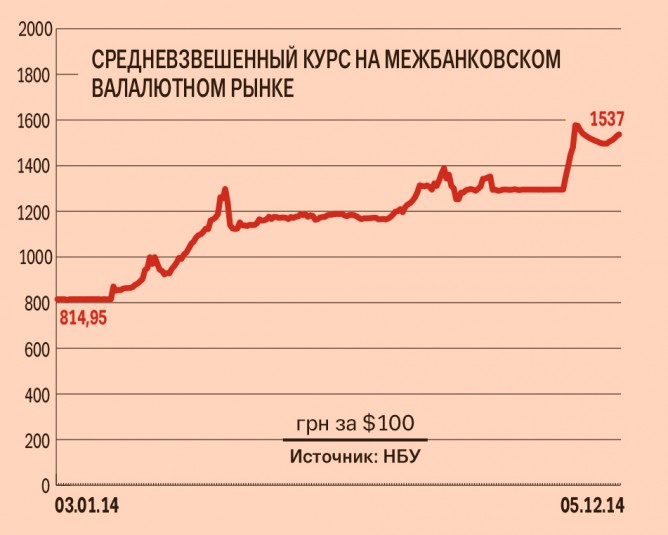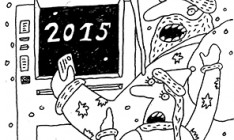Finance
currencyDollar exchange rate shot up again

Yesterday, the average weighted exchange rate of the U.S. dollar on the interbank market was UAH 15.37/USD. The fall of the hryvnia began at the end of last week on November 27. Within a week the U.S. dollar on the interbank market rose by 40 kopecks. Two weeks earlier, the hryvnia strengthened its positions from UAH 15.77/USD to UAH 14.96/USD. The new round of devaluation frightened those who bought foreign currency on the black market at the rate of UAH 17/USD.
Straight ahead
Bankers believe that the rate of UAH 17/USD is a sign of a panic. “The rate has found its stabilization at the level of UAH 15– 16/USD,” says Chairman of the Board of PUMB (FUIB) Serhiy Chernenko. Other bankers, on condition of anonymity, say the equilibrium rate is UAH 15.70–15.90/USD. Allegedly, the banks use this rate to settle accounts with their corporate clients – exporters with importers.
Still, only a very limited amount of currency makes it to the interbank market. The average daily volume of currency trading in November was 205 mn in U.S. dollar terms. Despite this, bankers say that exporters sell currency little by little. “Exporters’ needs for working capital are very high, so, whether they want to or not they have to sell the currency. In the last few weeks, the exporters’ volume of sales has been growing. The imbalance – namely, the difference between supply and demand – is in decline,” says Chernenko. According to him, while at the peak the bank had approximately UAH 2 bn on the account to which importers transferred hryvnia to buy foreign currency, at present there is only around UAH 700 mn. This means the demand for hard currency dropped by more than twice.
Nevertheless, the deferred demand is still very high and the hryvnia is still devaluating. “Next year we can expect crawling devaluation plus 10% of the current rate to UAH 17– 18/USD,” said Chernenko. The ICU Group made similar forecasts in its research reports. At the same time, according to the TRData Information System, 12-month non-deliverable currency forwards (NDF) were traded yesterday at the rate of UAH 18.3–19.5/USD. This means that the actual fears of financial experts are even worse.
For the next week the official hryvnia exchange rate will move towards UAH 16/USD, analysts say. The devaluation was assisted by the NBU, which earlier this week asked banks to place market quotes on daily auctions on which the indicative rate is defined. “If the banks follow such a principle (place market quotes - Ed.), then in the near future the indicative rate will start reflecting the moods of the market,” said Governor of the NBU Valeria Hontareva. In order to “stimulate” the banks to place market quotes the NBU even reduced the amount of currency sales on daily auctions from US $5 mn to US $3 mn.
Hontareva’s equilibrium
The task for currency auctions is to find the equilibrium rate, says Hontareva. After all, according to officials at the NBU, today it is impossible to set a fair rate on the interbank market. After introduction of a 0.5% tax on the purchase of hard currency in favor of the Pension Fund the volumes of the interbank fell sharply. As a result, since April 1 the banks have virtually ceased to trade currency with each other throughout the day. While in spring the average daily trading volume reached US $1 bn, today it is around US $200 mn. On such an illiquid market the price becomes ephemeral, say representatives of the NBU. Officials believe that the actual price can be set at the auction.
Noteworthy, not all banks share such a point of view. Earlier, the Independent Association of Ukrainian Banks (IAUB) proposed the NBU to cancel all currency auctions.
“Auctions that do not satisfy even 1% of the amount of the accumulated deferred demand for the currency only favor its increase and the resulting exchange rate does not reflect either the market or the weighted rate,” according to the IAUB press service. “As a result, most exporters are not in a hurry to bring export revenues to Ukraine in order to settle accounts beyond its borders or use different payment schemes that the bank cannot influence”. The NBU did not yield to the persuasions of banks. In turn, the market is also paying less attention to the official exchange rate, thus continuously forcing the NBU to catch up.







 of the agreement of syndication with Financial Times Limited are strictly prohibited. Use of materials which refers to France-Presse, Reuters, Interfax-Ukraine, Ukrainian News, UNIAN agencies is strictly prohibited. Materials marked
of the agreement of syndication with Financial Times Limited are strictly prohibited. Use of materials which refers to France-Presse, Reuters, Interfax-Ukraine, Ukrainian News, UNIAN agencies is strictly prohibited. Materials marked  are published as advertisements.
are published as advertisements.